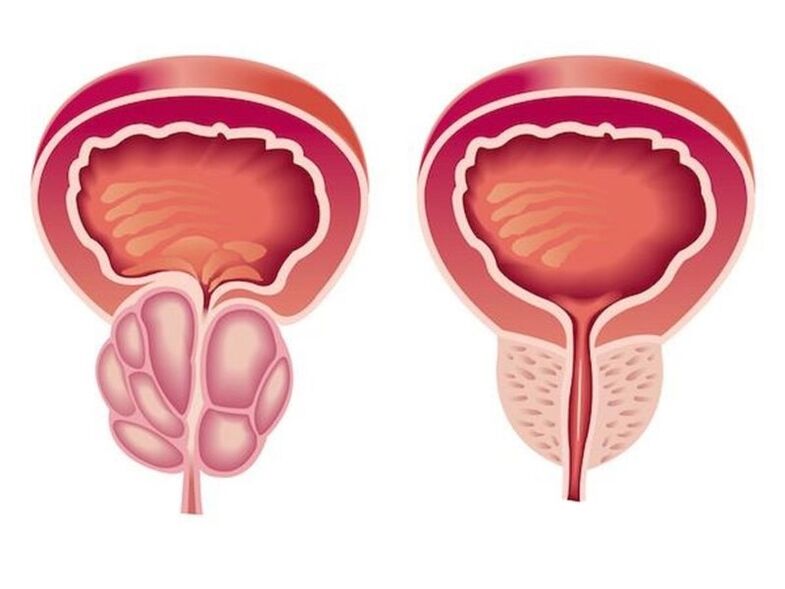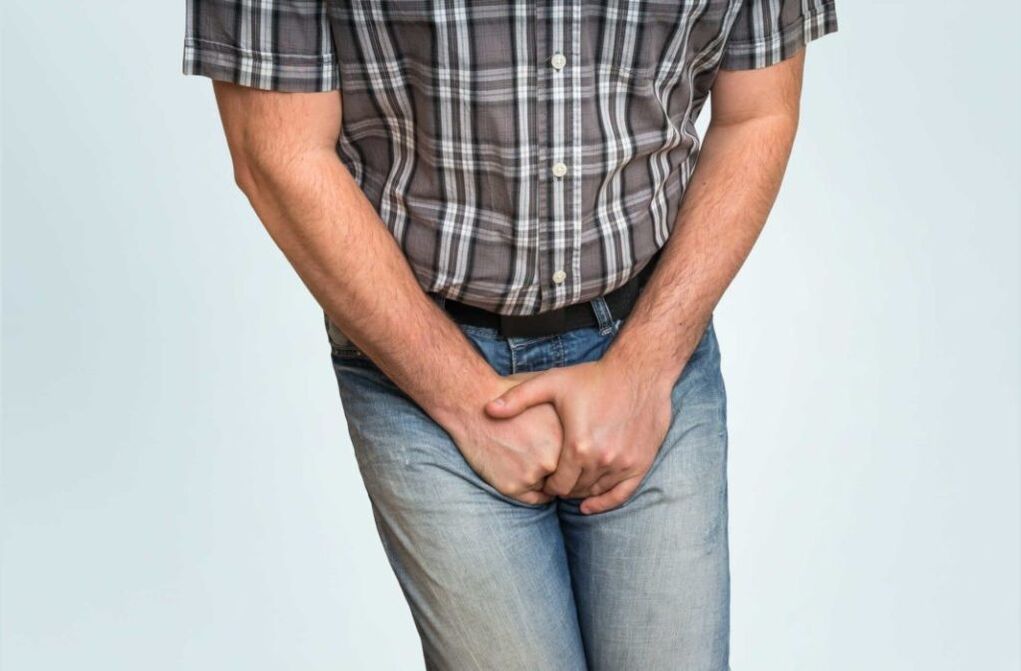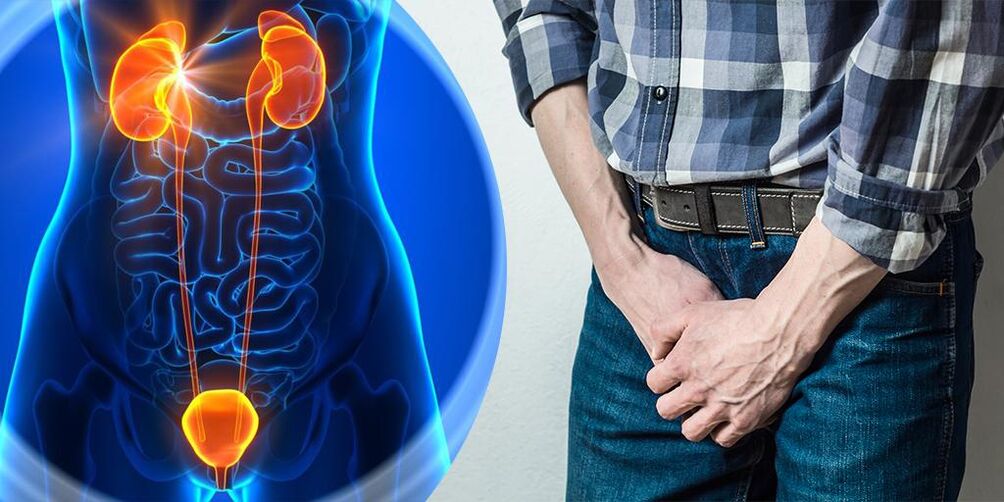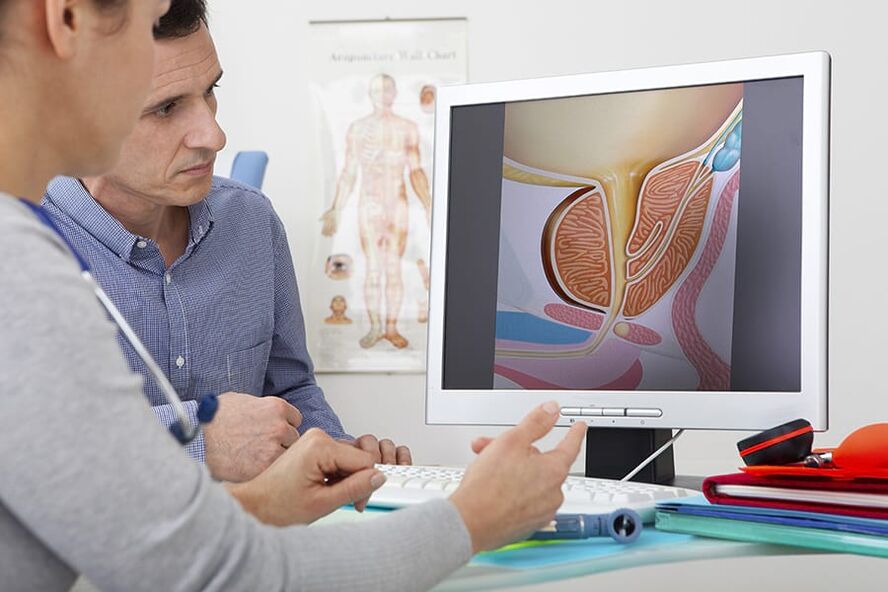Prostatitis is an inflammatory disease of the prostate gland. It is manifested by frequent campaigns in the toilet, pain in the penis, scrotum, rectum, sexual disorders (erection, early ejaculation, etc. ), sometimes delayed urine and blood insurance in the urine. The diagnosis of prostatitis is established by a urologist or another specialist in a typical clinical image, the results of a rectal study. In addition, an ultrasound of the prostate is carried out, sowing prostatic and urine secretion bacteria. Conservative treatment: antibacterial therapy, immunotherapy, prostate massage, lifestyle correction.

General Information
Prostatitis - Inflammation of the seed gland (prostate) - prostate. It is the most common disease of the genitourinary system in men. Most of the time it affects patients aged 25 to 50. According to several data, prostatitis suffers from 30-85% of men over 30 years. Perhaps abscessing the prostate gland, the inflammation of the testicles and appendices, which threatens infertility. The rise of the infection leads to the inflammation of the upper parts of the genitourinary system (cystitis, pyelonephritis).
The pathology develops when an infectious agent is entered, which enters the prostate tissue of the organs of the genitourinary system (urethra, bladder) or the remote inflammatory approach (with pneumonia, flu, amamazitis, furununculosis).
The causes of prostatitis
A staphylococcus aureus gold (Enterococcus), Enterobacter (Enterobacter), pseudomonas (pseudomonas), proteus (proteus) and Klebcelllah, and Klebcelllah can act as an infectious agent in an acute process. (Klebsiella) and E. coli (E. coli). Most microorganisms belong to the pathogenic flora conditionally and cause prostatitis only if there are other predisposing factors. Chronic inflammation is generally caused by Paul with microbial associations.
The risk of developing the disease increases during hypothermia, the presence of specific infections and conditions in the history of congestion in the prostate tissues. The following predisposing factors are distinguished:
- General hypothermia (unique or permanent, related to working conditions).
- A sedentary lifestyle, a specialty that forces a person to be sitting for a long time (computer operator, driver, etc. ).
- Constant constipation.
- Violations of the normal rhythm of sexual activity (excessive sexual activity, prolonged abstinence, incomplete ejaculation during the emotional coloration of the "usual" sexual relationship).
- The presence of chronic diseases (cholecystitis, bronchitis) or chronic infectious spotlights in the body (chronic osteomyelitis, absurd tooth decay, tonsillitis, etc. ).
- Urological diseases transferred (urethritis, cystitis, etc. ) and sexually transmitted diseases (trichomoniasis, gonorrhea).
- States that cause inhibition of the immune system (chronic tensions, irregular and lower nutrition, a regular lack of sleep, a state of athletes oversight).
It is assumed that the risk of developing pathology increases with chronic poisoning (alcohol, nicotine, morphine). Some studies in the field of modern Andrology show that the provocative factor is a chronic crical lesion (vibration, brain shock) in motorists, motorcyclists and cyclists. However, the overwhelming number of experts believes that all the circumstances listed are not real causes of the disease, but only contribute to the exacerbation of the latent inflammatory process in the prostate tissues.
The decisive role in the appearance of prostatitis is performed by stagnation in the prostate tissues. The violation of capillary blood flow causes an increase in lipid peroxidation, edema, exudation of prostate tissues and form conditions for the development of the infectious process.

Prostatitis symptoms
Acute prostatitis
There are three stages of acute prostatitis, which are characterized by the presence of a certain clinical image and morphological changes:
- Sharp catarron. Patients complain fast, often painful, pain in the sacrum and perineum.
- Sharp follicular. The pain becomes more intense, sometimes irradiated to the anus, intensifies during defecation. Urine is difficult, urine flows with a thin current. In some cases, urine delay is observed. Subfebrilita or moderate hyperthermia is typical.
- Acute parenchymal. The pronounced general poisoning, hyperthermia up to 38-40 ° C, chills. Dicizuric disorders, often an acute delay in urination. Sharp and pulsating pains in the perineum. Difficulty defecating.
Chronic prostatitis
In rare cases, chronic prostatitis becomes the result of an acute process, however, as a general rule, a primary chronic course is observed. The temperature occasionally increases to small values. The patient indicates weak pain in the perineum, discomfort during the act of urine and defecation. The most characteristic symptom is the scarce discharge of the urethra during the defecation act. The primary chronic form of the disease develops for a significant period of time. It precedes it by the stagnation of the blood in the capillaries, gradually becoming abacerial prostatitis.
Chronic prostatitis is often a complication of the inflammatory process caused by the causal agent of a specific infection (clamidia, ureplasma, gocococcus). The symptoms of a specific inflammatory process in many cases mask the manifestations of the prostate injury. A slight increase in pain is possible during urination, weak pain in the perineum, the scarce discharge of the urethra during defecation. A slight change in the clinical picture often goes unnoticed by the patient.
Chronic inflammation of the prostate gland can manifest itself through a sensation of burning in the urethra and perineum, dysuria, sexual disorders, greater general fatigue. The consequence of power violations (or fear of these violations) often becomes mental depression, anxiety and irritability. The clinical image does not always include all groups of symptoms listed, differs in different patients and changes over time. There are three main syndrome characteristic of chronic prostatitis: pain, violations when going to the bathroom, sexual disorders.
There are no pain receptors in the prostate fabric. The cause of pain in chronic prostatitis becomes almost inevitable due to the abundant innervation of the involvement of pelvic organs in the inflammatory process of nerve paths. Patients complain of pain of different intensity, from weak, hurt intense, violating the dream. There is a change in the nature of pain (improvement or weakening) with ejaculation, excessive sexual activity or sexual abstinence. The pain radiates in a scrotum, sacrum, crotch, sometimes in the lumbar region.

As a result of inflammation in chronic prostatitis, the volume of the prostate increases by pressing the urethra. Ureter light decreases. The patient has frequent urine, an incomplete emptying of the bladder. As a general rule, the dirty phenomena are expressed in the early stages. Then, the compensatory hypertrophy of the muscular layer of the bladder and the ureters develops. The symptoms of dysuria during this period are weakening, and then increase during the decompensation of adaptive mechanisms.
In the initial stages, violations in power can develop, which manifested differently in different patients. Patients may complain about frequent night erections, erased orgasm or deterioration of an erection. The accelerated ejaculation is associated with a decrease in the threshold of excitation of the center, which is responsible for obtaining an orgasm. The pain for ejaculation can cause a negative to sexual activity. In the future, sexual disorders become more pronounced. In an advanced stage, impotence develops.
The degree of sexual disorder is determined by many factors, including the sexual constitution and the patient's psychological mood. Violations of power and dysuria may be due to both changes in the prostate gland and how easily the patient can inspire anything. If you have chronic prostatitis, expect the inevitable development of sexual disorders and oratory disorders. Especially potential psychogenic disorders and problems to go to the bathroom develops in suggestible and alarming patients.
Complications
In the absence of timely treatment of acute prostatitis, there is a significant risk of developing the abscess of the prostate gland. When the purulent approach is formed, the patient's body temperature increases to 39-40 ° C and can acquire an agitated character. Heat periods alternate with pronounced chills. Acute pain in the perineum complicates urination and makes defecation impossible.
Edema edema growth leads to acute urination delay. In rare cases, the abscess opens spontaneously to the urethra or the rectum. When it opens to the urethra, purulent mud urine appears with an unpleasant smell, when opening in the rectum, the feces contain pus and mucus.
For chronic prostatitis, a wave -shaped course with prolonged remissions periods is characteristic, during which inflammation in the prostate occurs latent or manifests in extremely scarce symptoms. Patients, whom nothing gets upset, often stops treatment and becomes only the development of complications.
The most frequent complication of the chronic process is the inflammation of the testicles and appendices of the testicles and the inflammation of seed bubbles. The result of these diseases often becomes infertility.
Diagnosis

A characteristic clinical image simplifies the diagnostic process in acute and chronic prostatitis. Mandatory is done:
- Rectal prostate study
- The fence of the secretion of the prostate gland to determine the sensitivity of the microflora (sow the secret of the prostate and the sowing urine to the bacteria).
- An ultrasound of the prostate is carried out to identify structural changes (tumors, cysts, adenoma) and differentiation of prostatitis of other diseases
- A sperm to exclude or confirm the development of infertility.
Prostatitis treatment
Treatment of acute prostatitis
Patients with an acute process without complication are submitted to a treatment course with a urologist outpatiently. With severe poisoning, the suspicion of a purulent process, hospitalization is indicated. Antibacterial therapy is carried out. The medications are selected taking into account the sensitivity of an infectious agent. Antibiotics are widely used that they can penetrate well into the prostate tissue (ciprofloxacin, etc. ).
With the development of acute urine delay, in the context of prostatitis, they resort to the installation of a special tube, and not to a urethral catheter, because there is the danger of the formation of an abscess of the prostate. With the development of the abscess, an endoscopic transceral or urethral opening of the abscess is carried out.
Treatment of chronic prostatitis
The treatment of chronic prostatitis should be complex, including ethiotropic therapy, physiotherapy, immunity correction:
- Antibiotic therapyThey are prescribed long-term antibacterial courses (within 4-8 weeks). The selection of the type and dose of antibacterial drugs, as well as the determination of the duration of the treatment course is carried out individually. The medicine is chosen based on the sensitivity of microflora depending on the results of the sowing of urine and the secret of the prostate.
- Prostate massage. The gland massage has an integral effect on the affected organ. During the massage, the inflammatory secret accumulated in the prostate gland is squeezed in the ducts, then enters the urethra and takes off the body. The procedure improves blood circulation in the prostate, which allows to minimize stagnation and provides the best penetration of antibacterial drugs in the tissue of the affected organ.
- Physiotherapy. To improve blood circulation, laser exposure, ultrasonic waves and electromagnetic vibrations are used. If it is impossible to carry out physiotherapeutic procedures, the patient is prescribed warm medicinal microclines.
In long -term chronic inflammation, a consultation of an immunologist is indicated for the choice of tactics of immunocoria therapy. The patient receives recommendations for a change in lifestyle. The introduction of certain changes in the lifestyle of a patient with chronic prostatitis is therapeutic and a preventive measure. The patient is recommended to normalize sleep and vigil, establish a diet and perform moderate physical activity.

Forecast and prevention
Acute prostatitis is a disease that has a tendency pronounced to chronicle. Even with adequate timely treatment, more than half of the patients, chronic prostatitis becomes a result. However, recovery is far from possible, with the correct sequential therapy and compliance with the doctor's recommendations, it is possible to eliminate unpleasant symptoms and achieve a long persistent remission in the chronic process.
Prevention consists in eliminating risk factors. It is necessary to avoid hypothermia, alternative sedentary work and with periods of physical activity, and eat regularly and completely. With constipation, laxatives should be used. One of the preventive measures is the normalization of sexual life, since both excessive sexual activity and sexual abstinence are risk factors in the development of prostatitis. If the symptoms of a sexual or sexually transmitted disease appear, you should consult a doctor in a timely manner.
























